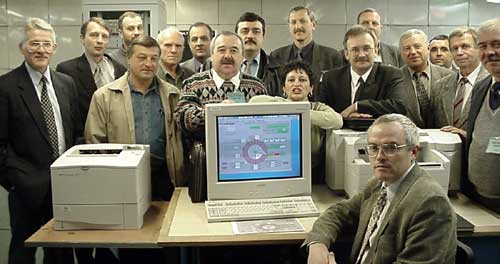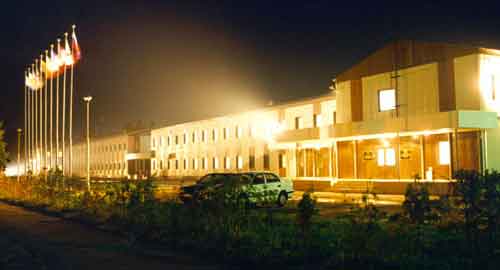
|
October 2000
Contents Highlights |
Armenia Bulgaria Czech Republic Hungary |
Kazakhstan Lithuania Russia Slovakia |
Ukraine United States Cross-Cutting Activities Planned Activities |
Highlights
Ukraine's seventh safety parameter display system passes site acceptance testing
System proves its worth prior to formal testing!
The newly installed safety parameter display system (SPDS) for Zaporizhzhya Unit 2 successfully completed site acceptance testing on October 12 and was turned over officially to the management of Zaporizhzhya nuclear power plant (NPP).
Just before site acceptance testing began for the system, the Zaporizhzhya Unit 2 reactor tripped. Ukrainian specialists on hand for the acceptance testing used the recently installed SPDS engineering workstation to review historical data captured by the SPDS. The data displays provided by the SPDS enabled reactor staff to determine the cause of the trip, analyze the effects of the trip on the plant, and prepare the unit for a safe restart. Engineers determined that the trip resulted when two of the four main coolant pumps shut down. Initially plant staff theorized that the pumps shut down because a valve had been opened inadvertently. However, review of the SPDS historical data revealed that all the valves were positioned properly.
 Prior to its site acceptance tests, the Zaporizhzhya Unit 2 safety parameter display system demonstrated its worth during an unexpected reactor trip. The engineers on site for the formal testing are shown here reviewing the SPDS data display to pinpoint the cause of the trip. Left to right are V. Veselsky, Khmelnytskyy NPP; A. Artym, Rivne NPP; M. Tregubov, Westron; V. Slezko, Rivne NPP; I. Aleksandrov and G. Shkalenko, Westron; O. Brenman, Westinghouse; T. Shevchenko, Westron; I. Rosenfeld, Burns & Roe; V. Bezsaliy, Nuclear Regulatory Administration; S. Kolesov, EnergoAtom; S. Slivka, Zaporizhzhya NPP; V. Borrisenko (seated), Nuclear Power Plant Operational Support Institute; I Ivanisov and V. Rudenko, Zaporizhzhya NPP; V. Goldrin, State Scientific and Technical Center for Nuclear and Radiation Safety; and V. Voronov, Crimea Center. |
Following the testing, the system was approved to begin pilot operation. Representatives of EnergoAtom and managers of Zaporizhzhya NPP signed a protocol accepting the SPDS. Other signatories included representatives from Ukraine's Nuclear Power Plant Operational Support Institute and Nuclear Regulatory Administration, as well as nuclear and technical specialists from Westron (the Ukrainian subcontractor), Westinghouse Electric Corporation (the U.S. SPDS supplier), and Burns & Roe Enterprises, Inc. (the U.S. subcontractor).
The SPDS is a computer system that displays a reactor's critical safety functions (reactor power, core cooling, primary coolant system integrity, secondary heat removal, and radiation containment) in the main control room, nearby shift supervisor's room, computer engineer room, and technical support center. The system monitors more than 2000 plant parameters such as temperatures, pressures, flows, water levels, neutron flux, and radiation levels. During any off-normal event, reactor operators and other key plant personnel are able to instantly see the status of the plant's safety functions. The information provided by the visual displays enables plant workers to quickly return the plant to a normal condition. U.S. experience following the Three Mile Island event has demonstrated the SPDS as a cost-effective way to reduce the likelihood that minor incidents will evolve into major accidents.
The system for Zaporizhzhya Unit 2 is the seventh of eleven SPDSs to be installed in Ukraine's nuclear power plants with VVER-1000 reactors. Under a U.S.-Ukrainian cooperative project to enhance the safety of Ukraine's Soviet-designed reactors, SPDSs already are installed in Khmelnytskyy Unit 1, South Ukraine Units 1 and 2, Rivne Unit 3, and Zaporizhzhya Units 3 and 5.
Systems yet to be installed are those for South Ukraine Unit 3 (late 2000) and for Zaporizhzhya Unit 4 (late 2000 or early 2001), Zaporizhzhya Unit 6 (early summer 2001), and Zaporizhzhya Unit 1 (mid-summer 2001). (Rich Reister, DOE, 301-903-0234; Rich Denning, PNNL, 614-424-7412) ![]()
Fourth annual Chornobyl Center conference is largest ever
The International Chornobyl Center for Nuclear Safety, Radioactive Waste and Radioecology hosted its fourth annual conference in late September. The conference, which focused on "Scientific, Technical, and Social Aspects of Chornobyl NPP Closure," attracted more than 300 participants from 10 countries to the Center's Slavutych Laboratory for International Research and Technology 40 km northeast of Chornobyl NPP. During the three-day event, the attendees participated in plenary and workshop sessions as well as tours of the Chornobyl plant and the Unit 4 Shelter.
 The International Chornobyl Center's Slavutych Laboratory was the setting for the Center's recent fourth annual conference on Chornobyl issues. This year's event drew the highest number of participants yet from the international scientific and technical communities. |
Three major speakers from the United States gave presentations during the information exchange:
- Dr. James Turner, U.S. Department of Energy, "Current and Future Strategies of the International Nuclear Safety Program"
- Mr. Vincent McClelland, International Emergency Cooperationo, "Use of Chornobyl NPP Emergency Management Center for Training on Emergency Preparedness"
- Ms. Anne Zollner, U.S. Department of Labor, "An Innovative Approach to Help Workers and Communities Cope with Enterprise Restructuring and Closures and Promote Economic Growth."
The number of participants in this year's conference was the largest ever, attesting to the high level of international interest in issues related to Chornobyl. Ukraine has agreed to shut down the Chornobyl plant by December 15 this year.
A complete description of the conference activities and outcomes is available on the Internet site for the Slavutych Laboratory at http://slirt.chornobyl.org/eng/conf/4.html.
Ukrainian President Leonid Kuchma created the International Chornobyl Center by decree on April 26, 1996, the 10th anniversary of the Chornobyl disaster. The Center was established to enable Ukraine to develop comprehensive, sustainable programs for evaluating and safely managing nuclear activities and facilities. The Center's administrative offices are in Kyiv. The principal technical work is conducted at its laboratory facilities in the city of Slavutych. (Riaz Awan, DOE, 38-050-257-7221; Don Draper, PNNL, 509-372-4079) ![]()
|
October 2000
Contents Highlights |
Armenia Bulgaria Czech Republic Hungary |
Kazakhstan Lithuania Russia Slovakia |
Ukraine United States Cross-Cutting Activities Planned Activities |